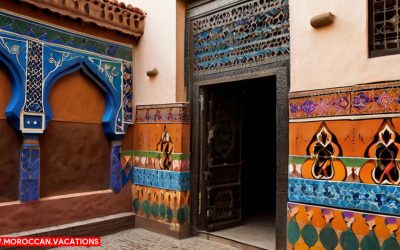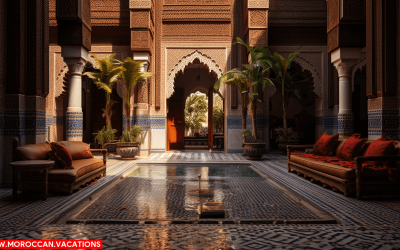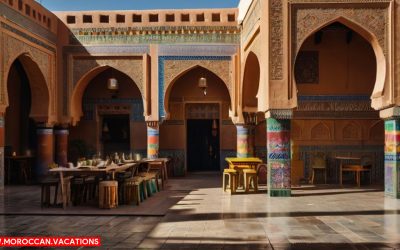Understanding Moroccan Pottery Heritage
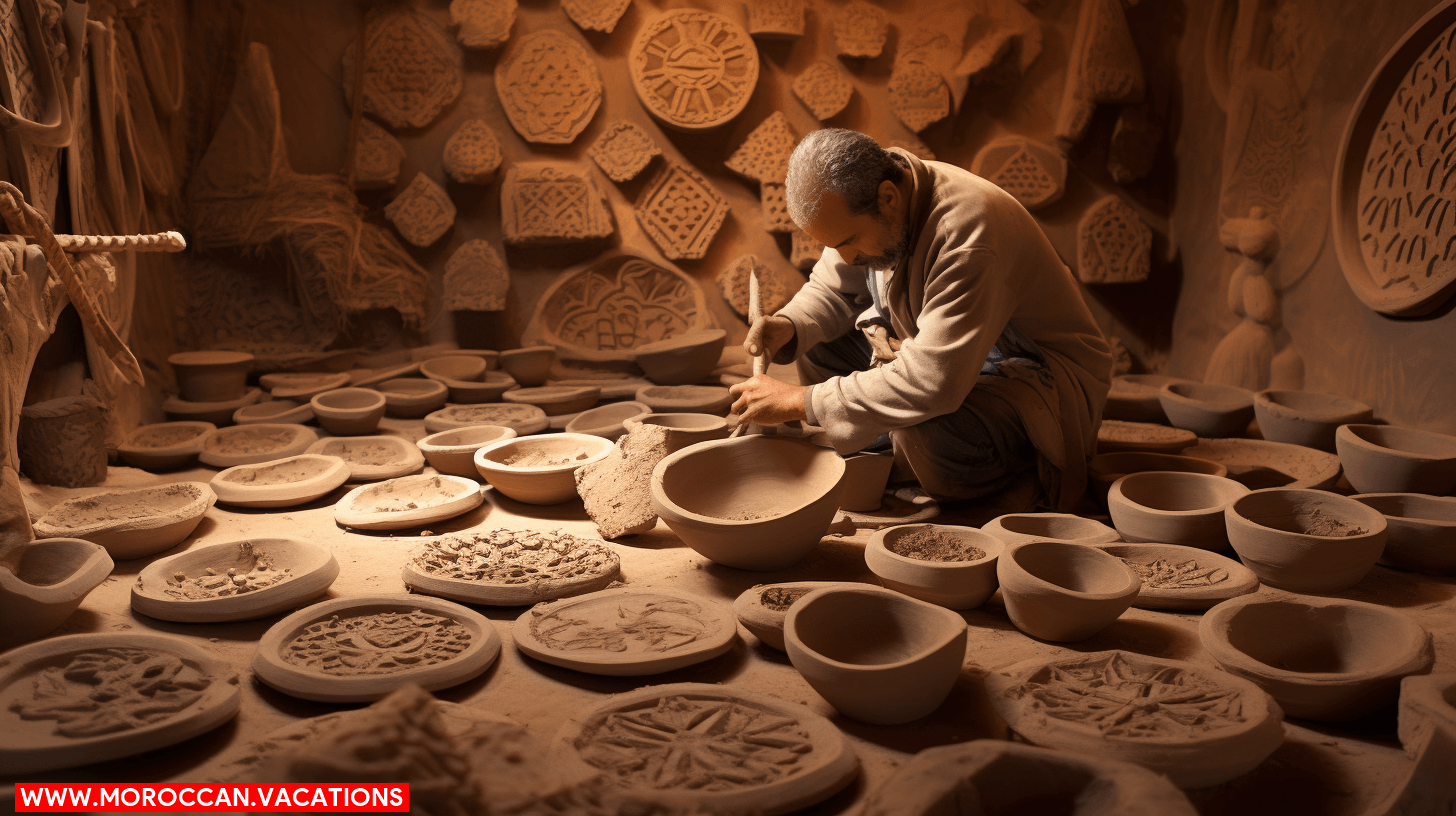

You’re about to embark on a creative journey, transforming raw clay into exquisite Moroccan pottery. This guide peels back the curtain on traditional pottery workshops, revealing the tools, techniques, and design elements that shape this rich heritage. You’ll get your hands dirty, master the pottery wheel, and breathe life into your own masterpiece. Whether you’re a novice or a seasoned potter, you’ll find this step-by-step guide enlightening. Let’s dive in and unleash your creativity.
Before you dive into the hands-on experience of pottery making, it’s crucial to grasp the rich heritage of Moroccan pottery, a craft deeply rooted in the nation’s culture and history. This art form carries a remarkable cultural significance, embodying the creativity, resilience, and freedom of the Moroccan people. It’s more than just a craft; it’s a testament to the country’s enduring spirit.
Over the centuries, Moroccan pottery has undergone an impressive artistic evolution. From the simple, earthy designs of ancient Berber tribes to the intricate, colourful motifs of Islamic and Andalusian influences, you can trace Morocco’s history through its pottery. Each piece tells a story of cultural exchange, adaptation, and innovation.
But it’s not all about the past. Today, contemporary Moroccan potters continue to push boundaries, blending traditional techniques with modern aesthetics. It’s this balance between the old and the new that keeps Moroccan pottery vibrant and relevant.
Essential Tools for Pottery Work
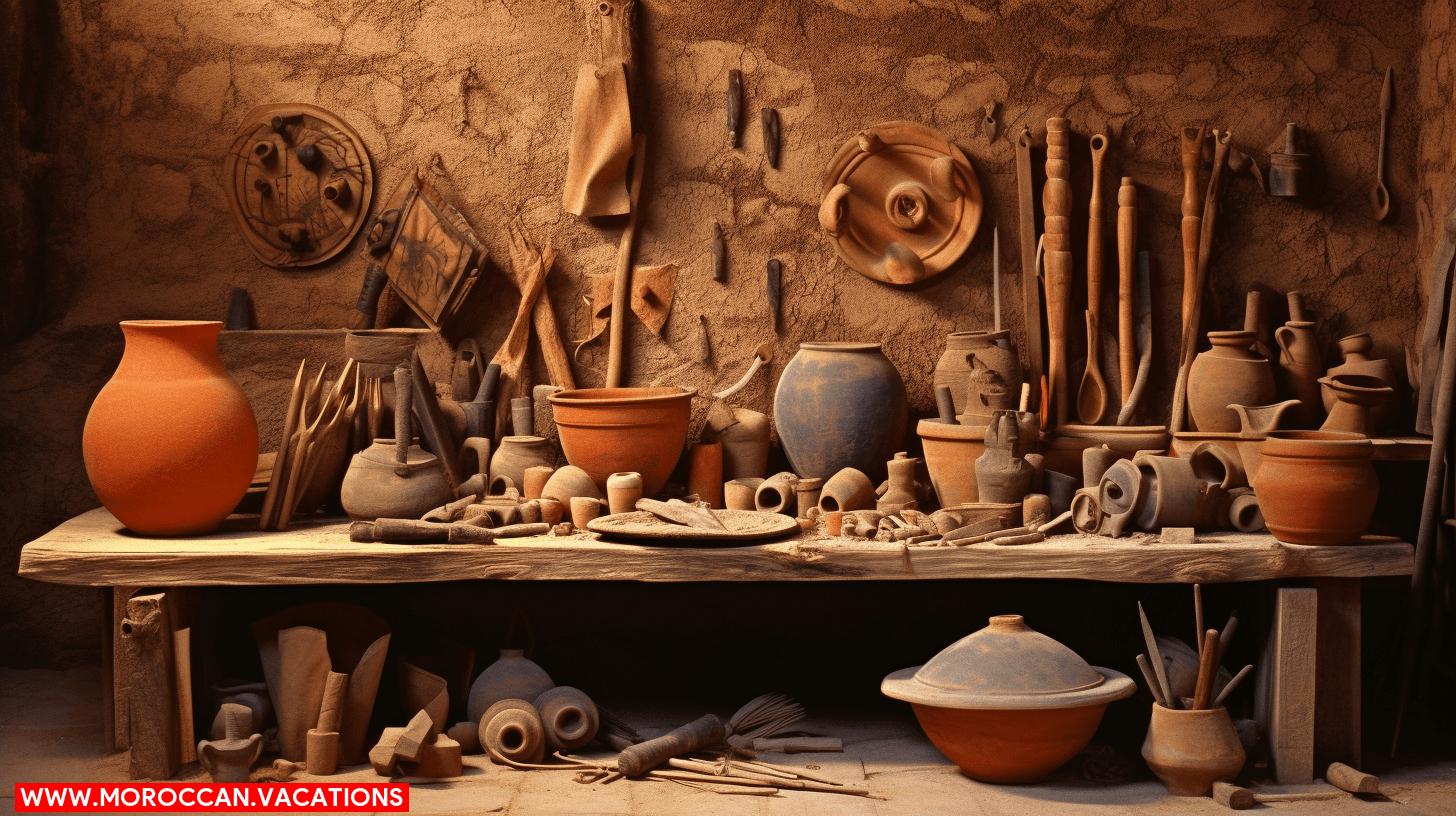

Now, let’s get your hands dirty and explore the essential tools you’ll need for your pottery work. The pottery wheel is your canvas; it’s where the magic happens. However, you’ll also need a host of other tools to create intricate designs and perfect shapes.
Your toolkit should include a wire clay cutter for slicing clay, rib tools for shaping and smoothing, and loop tools for carving and trimming. Needle tools are ideal for adding fine details, while wooden modeling tools offer versatility for a variety of tasks. Keep in mind that tool maintenance is crucial; regular cleaning ensures longevity and effectiveness.
In the world of pottery, there’s always room for innovation. Innovative gadgets, like electric pottery wheels, can give you a smoother, more controlled experience. Clay extruders can create consistent shapes and sizes, helping to speed up your workflow. And don’t forget about pottery software that can assist in designing and visualizing your creations.
Selecting Quality Clay
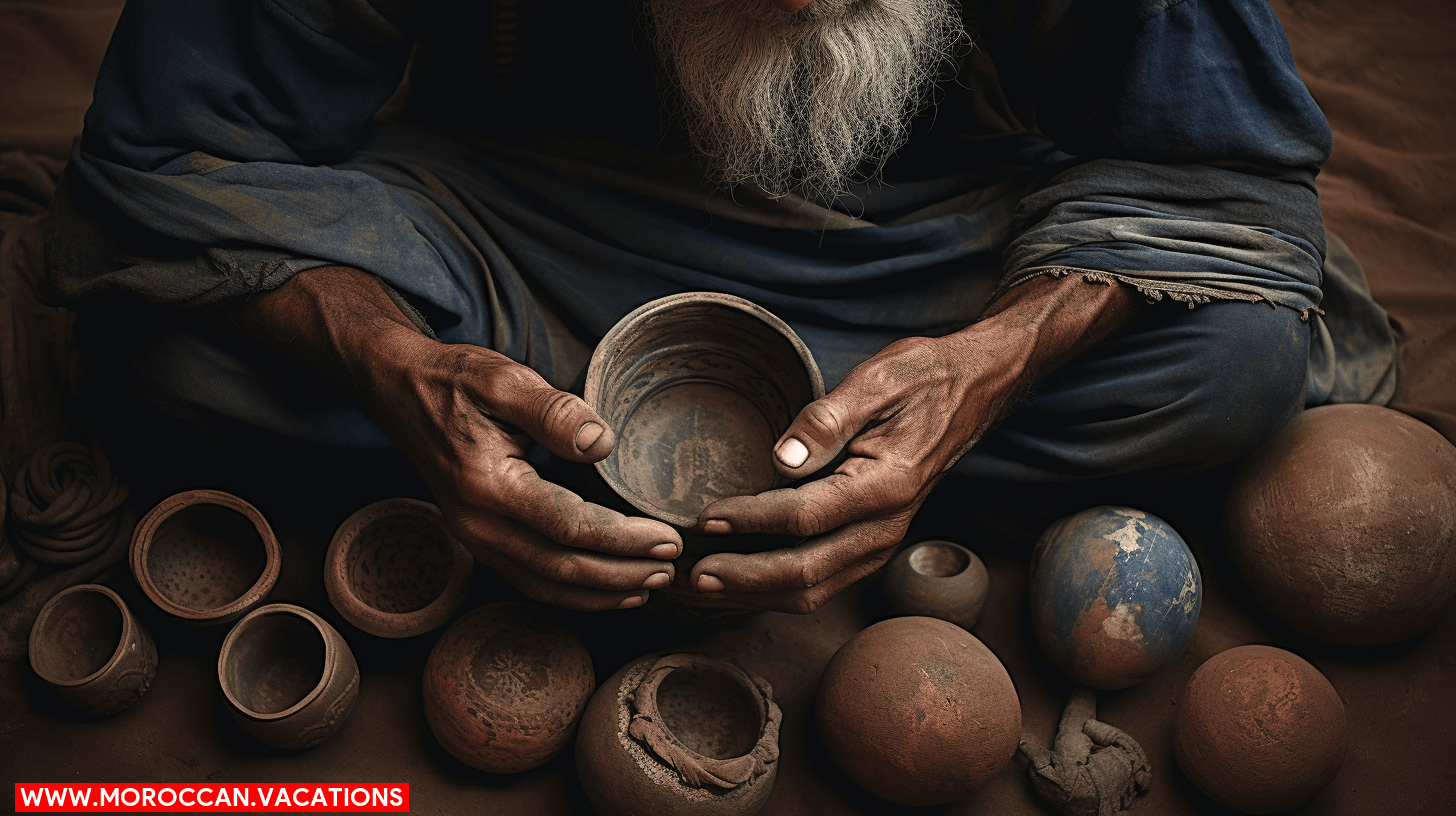

Armed with the right tools, your next step is to choose the quality clay that’ll transform under your skilled hands into an artistic masterpiece. Clay sourcing is a critical phase, and it’s not just about picking up a lump of earth. You’ll need to know about the different clay types and their properties.
Earthenware, stoneware, and porcelain are the primary clay types. Earthenware is soft and porous, ideal for decorative pieces. Stoneware is denser, perfect for functional items like bowls and mugs. Porcelain, the finest quality, is smooth and translucent when fired – perfect for delicate and intricate designs.
Your freedom in sculpting depends on the quality of the clay. The choice depends on what you’re creating and the finish you desire. Clay sourcing from reputable suppliers guarantees a consistent product. You’ll need clay that’s plastic (flexible and malleable), but also strong enough to hold shape.
Preparing the Clay
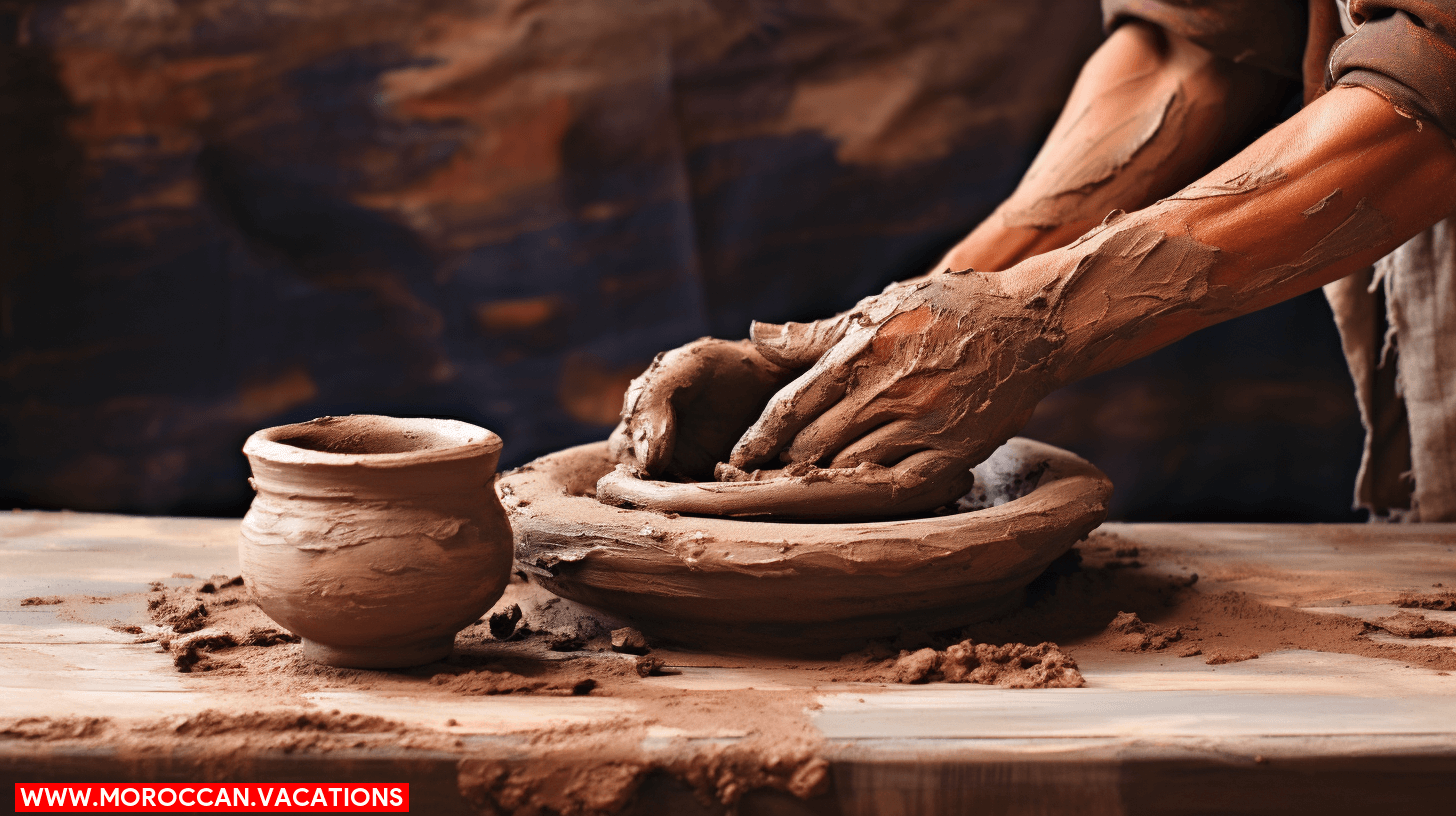

Once you’ve selected your clay, it’s time to prepare it for the craftwork ahead. All clay needs to be conditioned, regardless of where it’s sourced from. Conditioning is the process of making the clay more pliable and workable, removing any impurities, and ensuring a uniform consistency.
Clay sourcing is more than just digging up a lump of earth. It’s about selecting the right kind of clay for the specific project you’re working on. Moroccan pottery often uses locally sourced clays, known for their rich, earthy colours and excellent workability.
When it comes to clay conditioning, you want to start by soaking your clay in water. This breaks down the hard clods and makes the clay more malleable. You’ll then knead the clay to remove any air bubbles and ensure a uniform consistency. This is a crucial step as air bubbles can cause your pottery to break during firing.
Mastering the Pottery Wheel
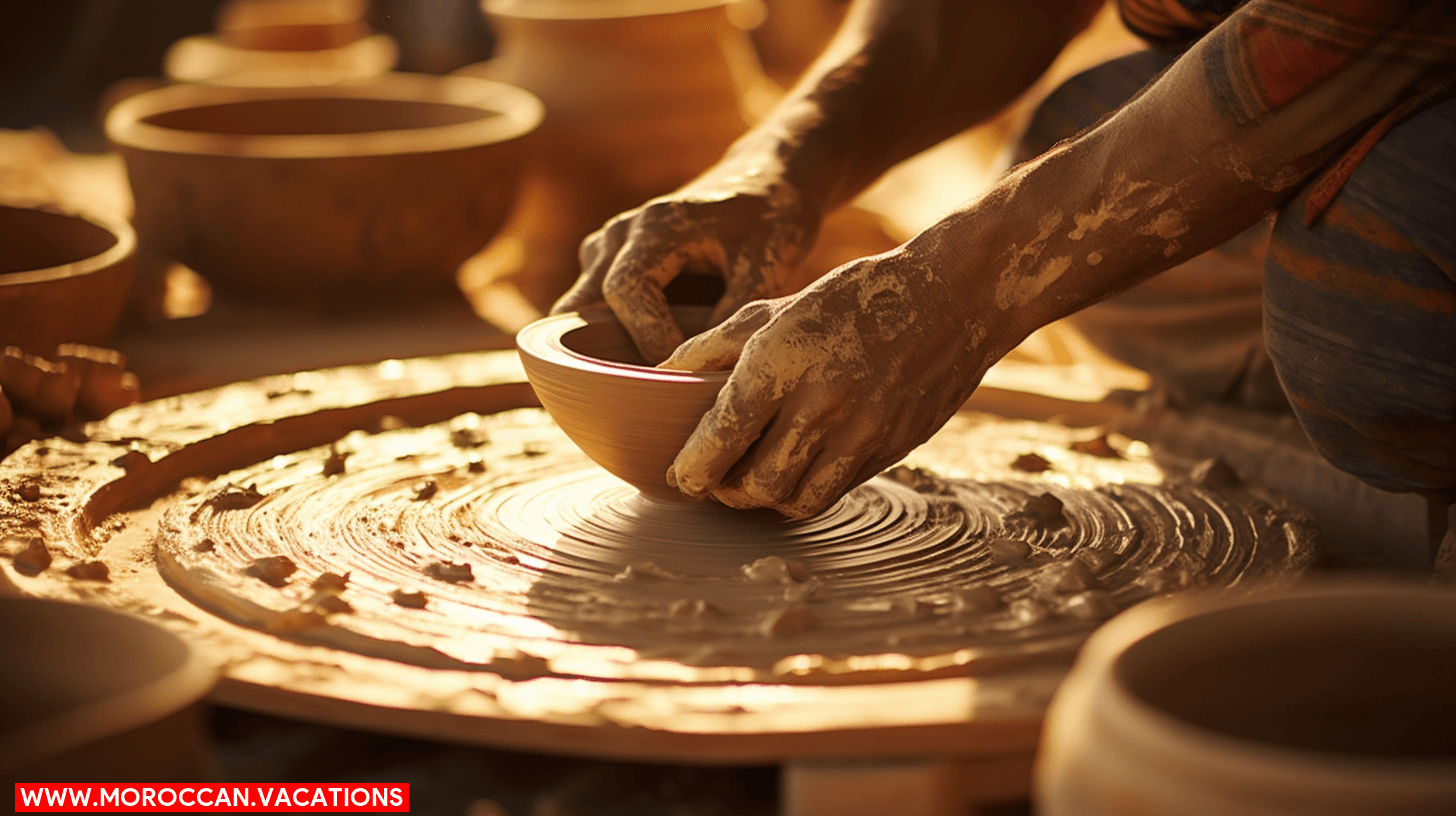

With your clay prepared and ready, it’s time to tackle the pottery wheel, a key tool in shaping your Moroccan pottery masterpiece. This stage, often referred to as wheel throwing, is where your freedom of expression truly shines.
Here’s a simplified four-step process to help you master the pottery wheel:
- Wheel Balancing: This involves centering your clay on the wheel. It’s critical for the overall symmetry of your piece. You’ll apply gentle pressure to the clay while spinning the wheel, ensuring the clay is evenly distributed.
- Opening the Clay: After balancing the clay, you’ll create a hole in the center, forming the inside of your pottery.
- Pulling the Walls: This is where you shape the body of your pottery. You’ll gently pull and stretch the clay walls, gradually forming your desired shape.
- Trimming and Finishing: After your piece has slightly hardened, you trim away excess clay and smooth the surface.
Mastering the pottery wheel takes patience, practice, and a sense of freedom. It’s a dance between your hands and the clay, a rhythm that transforms a simple lump of clay into an object of beauty and functionality.
Hand Building Techniques
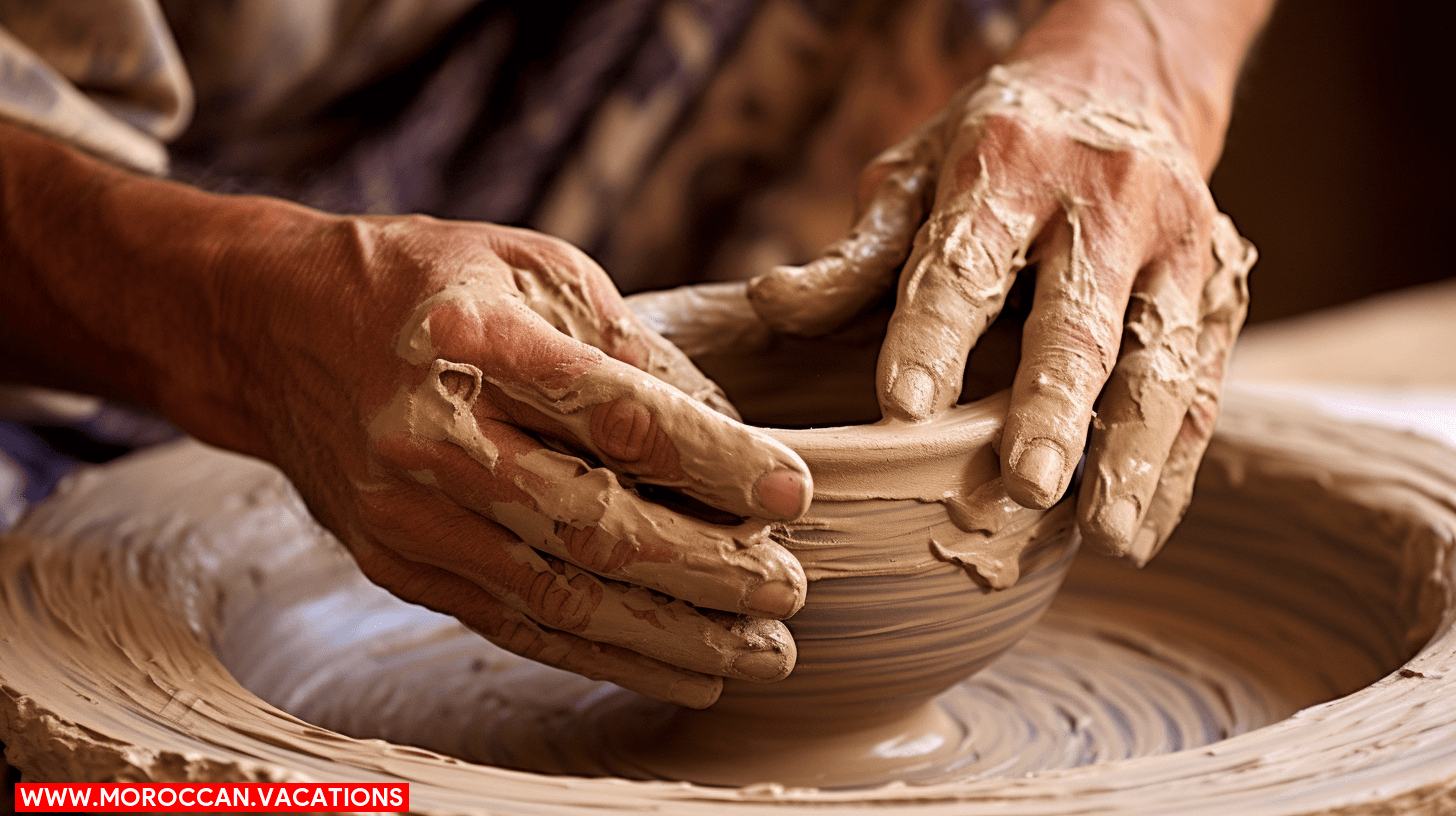

After mastering the pottery wheel, it’s time for you to explore the world of hand building techniques in Moroccan pottery. These techniques offer a level of freedom and creativity that’s hard to match. Two fundamental methods you’ll encounter are the Coiling Method and Slab Construction.
The Coiling Method involves rolling out long, snake-like pieces of clay and layering them to form the structure. It’s a slow process, offering you the freedom to shape and mold your piece as you go.
On the other hand, Slab Construction involves rolling out a slab of clay and cutting out shapes to assemble. This method allows you to create more angular and geometric designs.
| Technique | Freedom Level | Ideal For |
| Coiling Method | High | Organic, freeform shapes |
| Slab Construction | Medium | Geometric, structured designs |
| Wheel Throwing | Low | Symmetrical, rounded pieces |
| Pinching | High | Small, intimate creations |
| Extruding | Medium | Repeated, uniform shapes |
Moroccan Design Elements
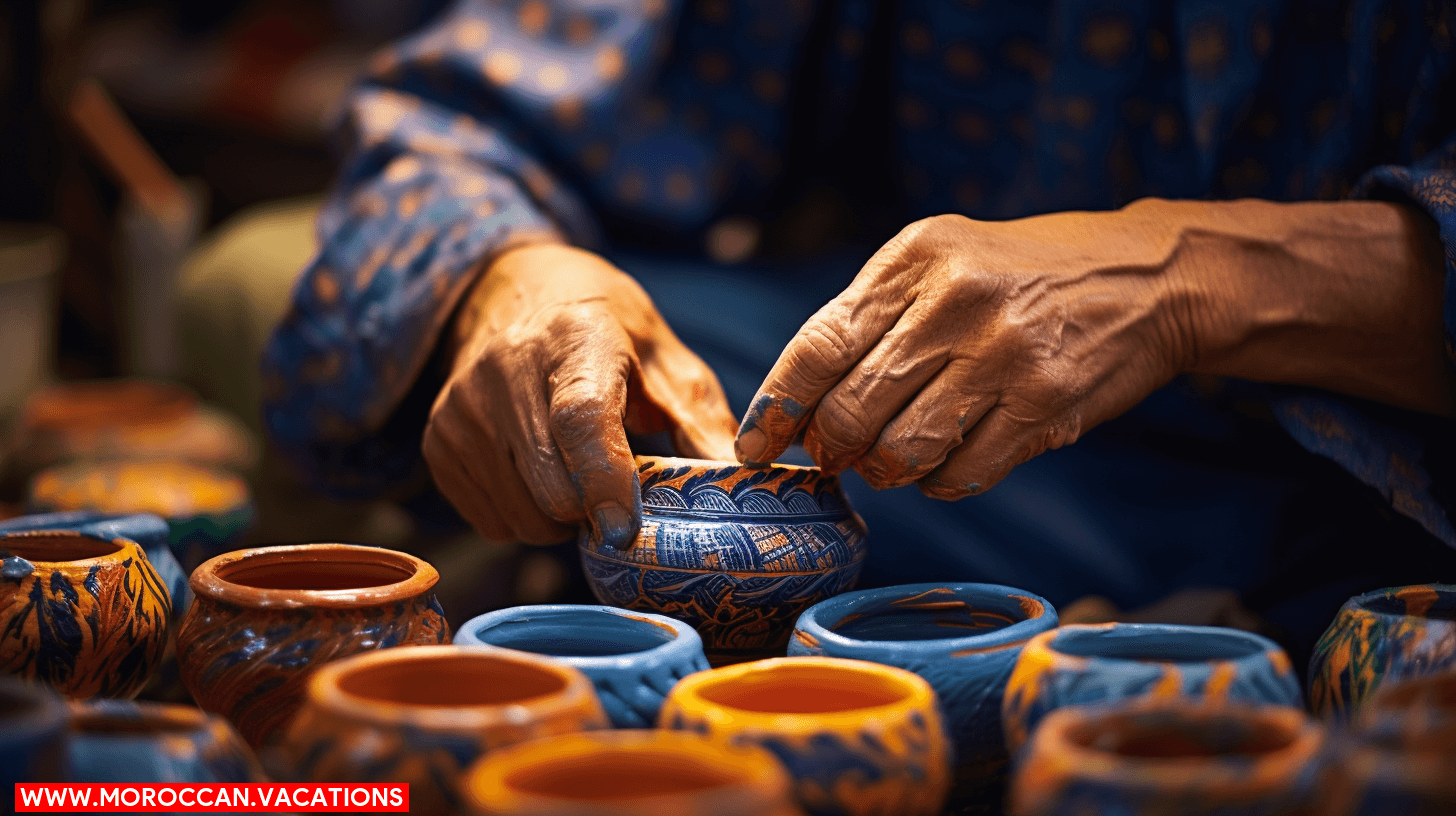

Diving into Moroccan design elements, you’ll find that they’re integral in adding distinct character to your pottery creations. You’re not just creating a piece of pottery, you’re crafting a story, a rich tapestry of cultural heritage and artistic freedom.
- Moroccan Tile Inspiration: Moroccan tiles, or Zellige, are a testament to the country’s rich and vibrant aesthetic. Their intricate geometric patterns and bold colors can inspire your pottery designs, infusing them with a sense of rhythm and balance.
- Berber Motifs Influence: Berber motifs, often abstract and symbolic, can deepen the meaning and beauty of your pieces. They’re not just designs; they’re narratives, cultural dialogues expressed through art.
- Color Palette: Moroccan color palettes are typically warm, earthy, and vibrant. They echo the country’s landscapes, from the red clay of the Atlas Mountains to the golden hues of the Sahara desert.
- Textures: The tactile quality of your pottery can enhance its visual appeal. Moroccan pottery often features rough, natural textures that contrast with smooth, polished surfaces.
Glazing and Decorating Tips
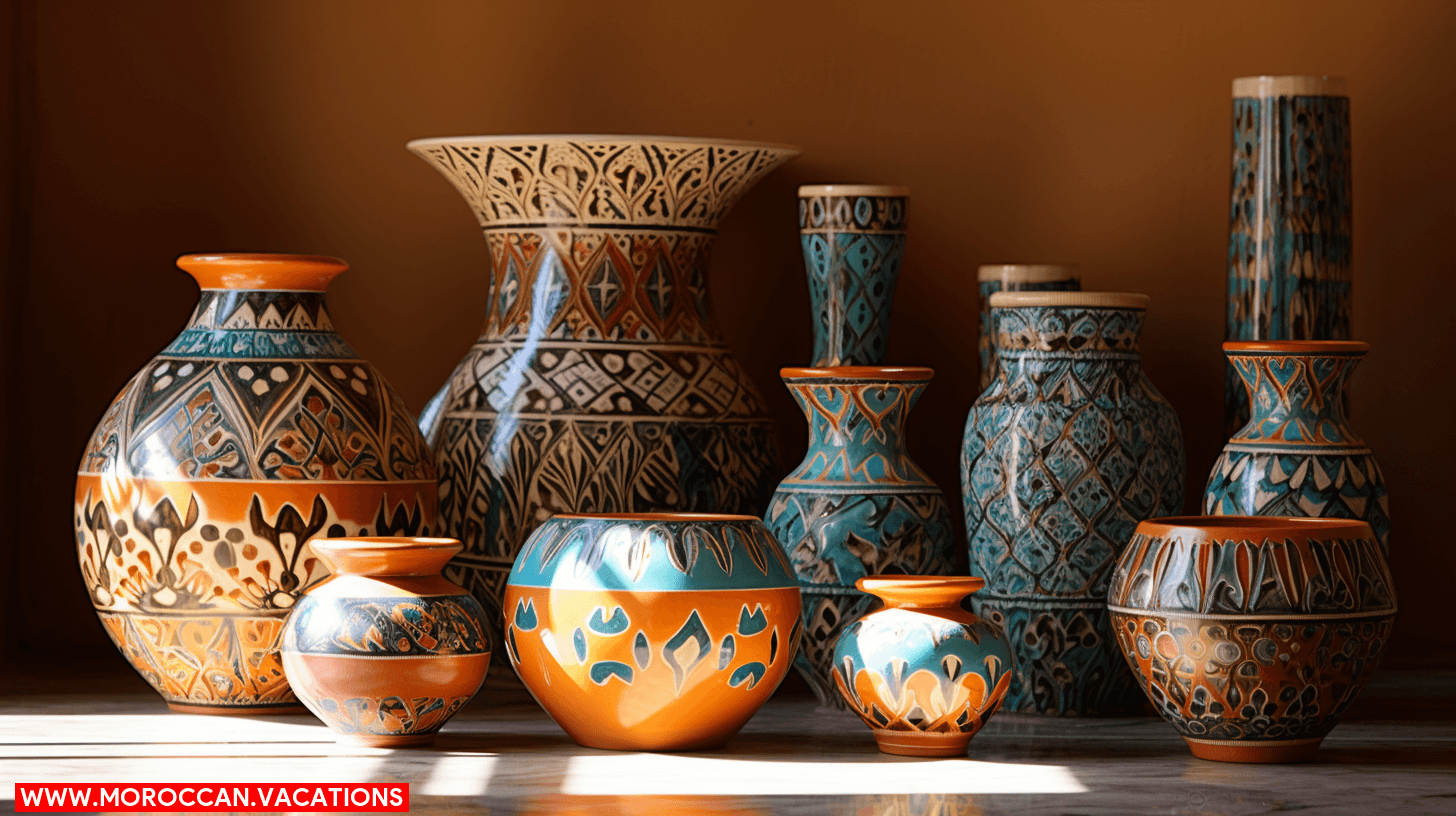

Drawing upon the inspiration of Moroccan design elements, you’re now ready to finish your pottery piece with glazing and decorating techniques that’ll truly make it a masterpiece. Glazing is not just a protective layer, but it’s your canvas for expression.
Color selection is vital to the process. Moroccan pottery is known for its vibrant colors; cobalt blue, turquoise, and earthy tones are commonly used. These colors reflect the landscape and culture of Morocco, giving your piece authenticity. Don’t be afraid to experiment with color combinations, harness your creative freedom to make a piece that resonates with you.
Glaze recipes, too, can be tailored to your artistic vision. Experiment with varying amounts of silica, clay, and flux to achieve different textures and finishes. Always remember to test your glaze on a small piece of clay before applying it to your masterpiece. This could save your piece from a disappointing outcome.
When decorating, embrace the intricate designs of Moroccan art. Geometric patterns, floral motifs, and calligraphy are all traditional elements you could include. Remember, the details you add are what will transform your clay piece into a true Moroccan masterpiece.
Kiln Firing Process
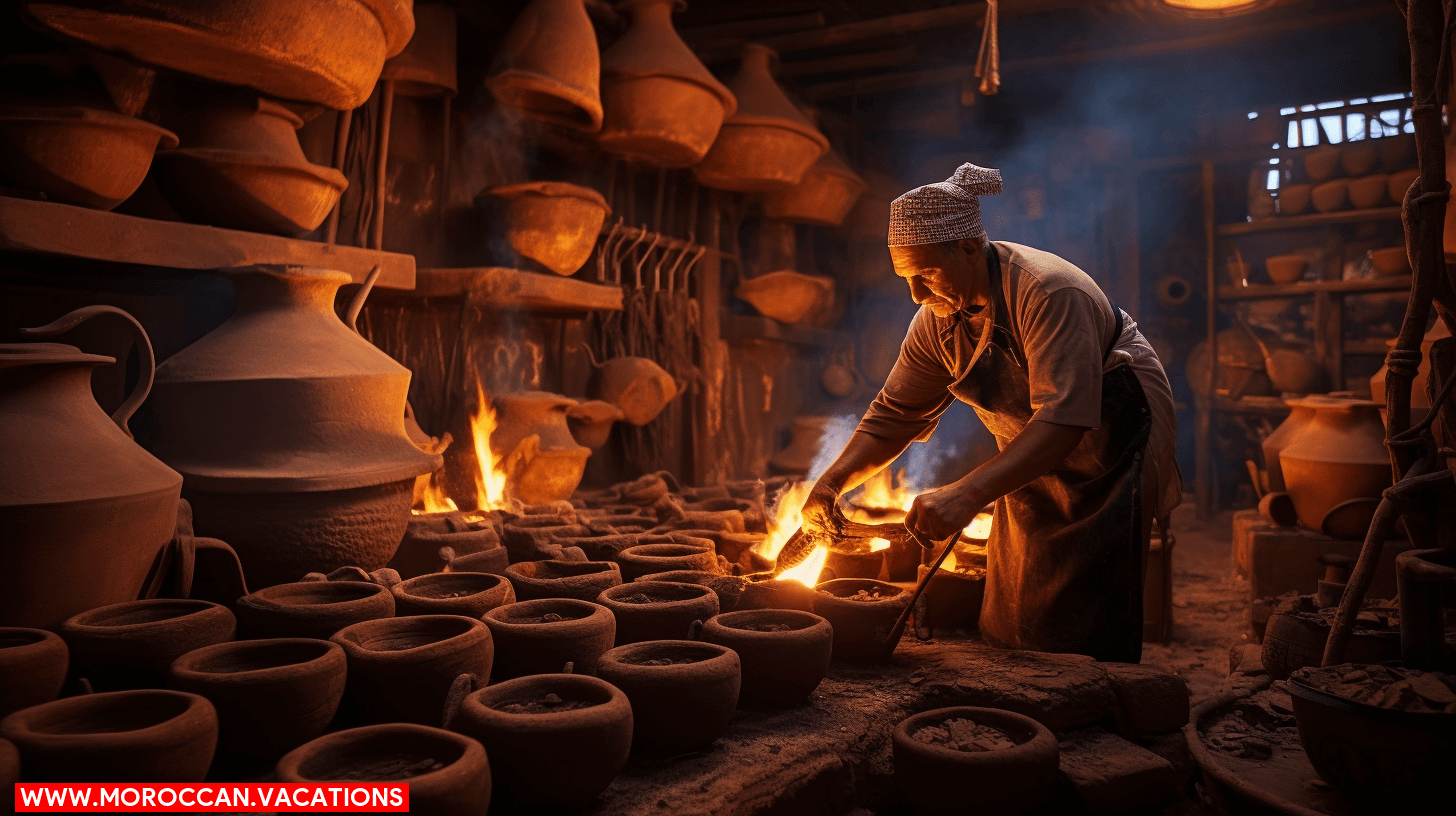

Once you’ve masterfully glazed and decorated your piece, it’s time to turn your attention to the crucial step of kiln firing. This process, which transforms your clay creation into a lasting work of art, involves a precise balance of time, temperature, and technique.
Four key steps make up the kiln firing process:
- Choosing the Right Kiln: There are various kiln types, each with unique qualities. Traditional Moroccan pottery often uses wood-fired kilns for their unique effects on glaze colors.
- Setting the Correct Firing Temperatures: The initial ‘biscuit’ firing is usually set at around 1000°C, while the final ‘glaze’ firing can reach temperatures of up to 1300°C.
- Monitoring the Process: It’s important to keep an eye on the kiln throughout the firing process, adjusting temperatures and ventilation as needed.
- Cooling Down: After the firing, the kiln must cool down slowly to prevent the pottery from cracking.
Understanding and mastering the firing process gives you the freedom to create pottery that isn’t just beautiful, but durable and functional too. Remember, the magic of pottery lies not just in shaping the clay, but in the transformative power of the kiln.
Caring for Your Masterpiece
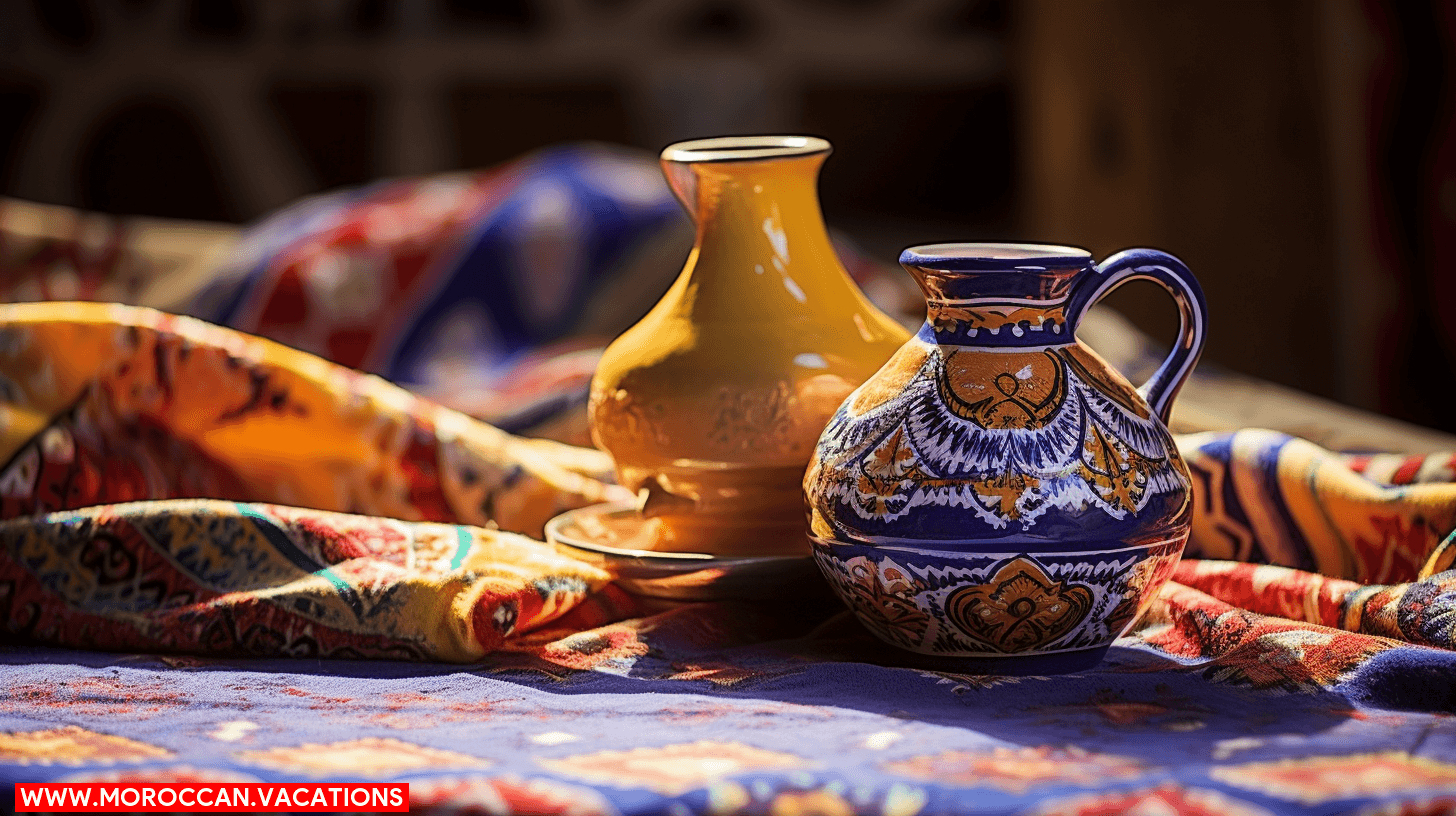

After your pottery piece has been skillfully fired and cooled, it’s crucial to learn how to properly care for your new masterpiece to ensure its longevity. Masterpiece preservation isn’t a one-size-fits-all process; it requires a thoughtful approach that respects the unique nature of your piece.
To begin with, it’s essential to keep your pottery in a dry, cool place. Rapid changes in temperature or humidity can cause cracks or breaks. If you’re using your pottery for functional purposes, avoid harsh chemicals and abrasive cleaning tools; warm water and a soft cloth will do the job and won’t damage the pottery’s surface.
Display options are also a part of the preservation process. Consider placing your masterpiece in a location where it’s less likely to be knocked over or damaged. If you’re showcasing it in a high-traffic area, make sure it’s secure.
Remember, your masterpiece also needs regular dusting. Use a soft, dry cloth to keep it looking its best. Also, refrain from using too much force while doing so, as this can lead to unwanted scratches.
Caring for your Moroccan pottery piece isn’t just about preservation, but also about enjoying its beauty and craftsmanship for years to come.
Introducing Ayoub Karbachi, a brilliant wordsmith and curator of the Moroccan Vacations website. Prepare to immerse yourself in mesmerizing narratives and extraordinary moments, as he unveils the allure of Morocco's captivating destinations like never before.
Related Articles
Traditional and Contemporary Art in Marrakesh: A Fusion of Cultures
The Rich History of Marrakesh's Art Step into the vibrant world of Marrakesh, where the past and present collide in a mesmerizing fusion of cultures. Traditional and contemporary art intertwine, creating a tapestry of creativity that captivates the senses. From the...
The Significance of Calligraphy in Marrakesh's Artistic Expression
Historical Roots of Calligraphy in Marrakesh Explore the importance of calligraphy in Marrakesh's art. Discover its deep history and cultural meanings. Learn how Islamic calligraphy shapes the lively art scene. Find out about the tools and techniques used. See how...
The Intersection of Tradition and Modernity: Marrakesh's Art Scene
The Rich Heritage of Marrakesh's Art Step into the vibrant world of Marrakesh's art scene, where tradition and modernity collide in a captivating dance. Here, ancient crafts intertwine with contemporary artistry, creating a tapestry of creativity that will leave you...

